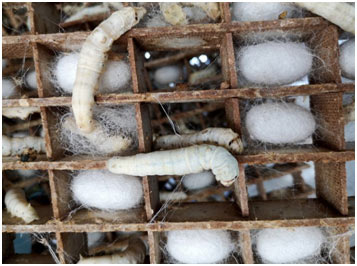Silkworm
Basically, the silkworm is the commercially bred caterpillar of the domesticated silkmoth Bombyx mori, which spins a silk cocoon that is processed to produce silk fiber.
The varieties Bombyx mori is usually grown and are increased under-regulated and controlled atmosphere as well as nourishment.
The Life Cycle of Silkworm:
Stage 1: Egg
An egg is the initial stage of the life cycle of a silkworm. The egg is laid by a female moth which is mostly the dimension of little dots. A female moth lays more than 350 eggs at once. In the springtime, the eggs hatch out because of the warmth in the air. This process takes place once every year.
Stage 2: Silkworm
An unshaven silkworm emerges after the eggs split. In this phase of silkworms, the growth takes place. They prey on mulberry fallen leaves as well as eat a large quantity of these leaves for around thirty days before moving to the next stage.

Stage 3: Cocoon
In this stage, it turns its head, rotating a fiber made of a protein as well as ends up being a silk fiber. By these fibers, they create a protective cocoon around itself. It is the size of a small cotton ball and is constructed from a solitary thread of silk.
Stage 4: Pupa
The pupa stage is a stationary stage. In this phase, the pupa shields itself inside the cocoon and remains dormant.
Stage 5: Moth
In this stage, the pupa changes into a grown-up moth if the cocoon made it through. The moth with totally established wings emerges out of the cocoon. The female moth lays eggs after mating as well as hence the life cycle of the silkworm begins again.
The Silk Production

1.Production of Cocoon:
The silk moth is kept in controlled environmental conditions. The moth lays hundreds of eggs. The silk moth’s eggs hatch out to create larvae or caterpillars, referred to as silkworms. The larvae feed upon mulberry fallen leaves.
After having actually grown and molted numerous times, the silkworm pushes out silk fibers to make a net to hold itself. It turns its head from side to side in a figure ‘8’ dispersing the saliva that will certainly develop silk.
The silk solidifies when it comes in contact with the air. Hence, they form a cocoon in which the silkworm encloses itself for about two or three days.
The silkworm spins about one mile of filament to complete a cocoon. The amount of useful quality silk in each cocoon is small. Because of this, about 2,500 silkworms are needed to create a single pound of raw silk.
2.Recuperation of Cocoon:
Two methods are popular for recuperating the cocoon of the silkworm. They are as follows:
A. The cocoons obtained from silkworms are then boiled, eliminating the silkworm pupa inside it. The silk filaments are obtained by cleaning the undamaged cocoon to locate the outside ends of the filament.
The silk filaments are after that wound on a reel. One cocoon contains about 1,000 yards of silk filament. The silk at this phase is known as raw silk. One string consists of approximately 48 specific silk filaments.
B. Filature procedures:
The cocoons raised by the farmer are delivered to the manufacturing facility, called a filature, where the silk is unwound from the cocoons and also the hairs are accumulated right into skeins.
The filature operations include adhering to stages:
- Sorting cocoons:
The cocoons are arranged according to the shade, dimension, form, and texture as this impacts the quality of the silk. Cocoons may vary from white as well as yellow to grayish.
- Softening the Sericin:
Silk filament is a dual hair of fibroin protein, which is held together by a gummy material called sericin or silk gum. After the cocoon has been arranged, they are put through a collection of hot and cold immersions, as the sericin should be softened to permit the unwinding of the filament as one continuous string.
- Reeling the filament:
Reeling is the procedure of unwinding the silk filaments from the cocoon as well as incorporating them together to make a string of raw silk.
Three to ten strands of silk filaments are typically reeled at a time to create the desired size of raw silk which is known as “reeled silk”. The usable size of reeled filament is 300 to 600 m.
- Bailing:
The silk filament is reeled into skeins, which are packed in tiny bundles called books, weighing 2 to 4.5 kg. These books are put into bales weighing about 60 kg. In this kind, raw silk is shipped to silk mills throughout the world.

